Power Pitch
Spectroscopy 1H & All
ISMRM & ISMRT Annual Meeting & Exhibition • 10-15 May 2025 • Honolulu, Hawai'i

| 13:30 |
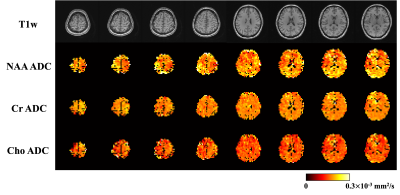 |
Screen Number: 26
0591. Whole-Brain,
High-Resolution Diffusion-Weighted MRSI with Improved Phase
Correction
Z. Wang, F. Lam
University of Illinois, Urbana-Champaign, Urbana, United States
Impact: The proposed method advanced capability of in
vivo DW-MRSI and may facilitate
compartment/cell-type-specific tissue microstructural
investigations.
|
| 13:32 |
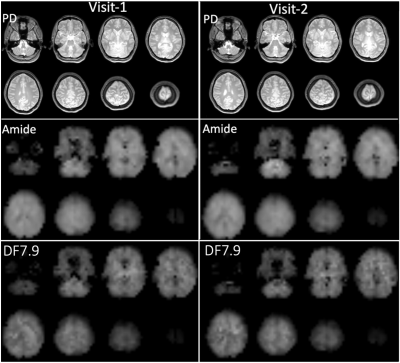 |
Screen Number: 27
0592. Assessing
the reproducibility of downfield MRSI in the human brain at 3T
İ. Özdemir, S. Etyemez, P. Barker
Johns Hopkins University, Baltimore, United States
Impact: 3D DF-MRSI at 3T is a highly reproducible tool.
In the future it may be useful in for studies of amides and
other resonances in pathological conditions.
|
| 13:34 |
 |
Screen Number: 28
0593. Phase
Correction of MRSI Data Using Model-Based Signal Estimation and
Extrapolation
W. Jin, R. Guo, Y. Li, Y. Zhao, X. Li, X-H Zhu, W. Chen, Z-P
Liang
Beckman Institute for Advanced Science and Technology, University of Illinois at Urbana-Champaign, Urbana, United States
Impact: We propose a novel method for effective phase
correction of MRSI data. This method is expected to provide
a useful tool for processing, quantifying, and analyzing
MRSI data.
|
| 13:36 |
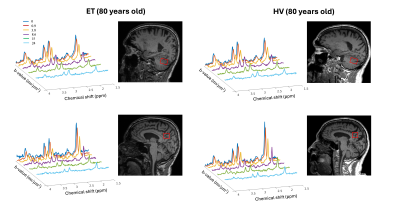 |
Screen Number: 29
0594. Non-gaussian
diffusion of the major intracellular metabolites is sensitive to
cerebellar microstructural alterations in essential tremor.
G. Genovese, K. Șimșek, M. Palombo, S. Lehéricy, C. Gallea,
F. Branzoli
Norwegian University of Science and Technology, Trondheim, Norway
Impact: -Feasibility of in-vivo investigation of
microstructural changes associated with cerebellar atrophy
in patients with essential tremor.-Feasibility of using
DW-MRS in clinical settings to measure non-Gaussian
diffusivities of metabolites and provide insights into
secondary neuronal structures.
|
| 13:38 |
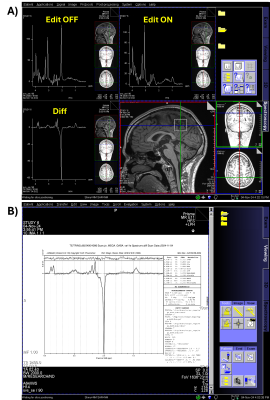 |
Screen Number: 30
0595. Automatic,
Online Reconstruction of Advanced Single Voxel and Spectroscopic
Imaging Sequences
P. Truong, K. Chow, L. Cui, L. Burki, J. Rock, S. Ahn, J.
Near
Sunnybrook Research Institute, Toronto, Canada
Impact: We demonstrate the benefit of automatic
reconstruction and analysis pipelines for spectroscopy,
integrated on-scanner with FIRE. The proposed framework
benefits collaborative work as complete containerized
environments for processing and analysis can be shared
between research sites.
|
| 13:40 |
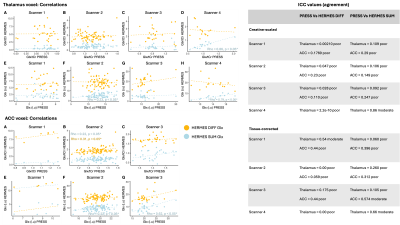 |
Screen Number: 31
0596. In
vivo Glx measurements from GABA-edited HERMES at 3T are not
consistent with those from short-TE PRESS across scanners,
regions, and age groups.

A. Thomson, P. Aggensteiner, H. Roeyers, T. Falck-Ytter,
E. Loth, J. Buitelaar, D. Murphy, T. Arichi, N. Puts
King's College London, London, United Kingdom
Impact: In a large sample, we show that HERMES (TE =
80ms) Glx estimates are not consistent with paired Glx
measurements from short-TE PRESS, highlighting the need for
consideration during MRS sequence selection, integrating
data across different acquisitions, and data interpretation.
|
| 13:42 |
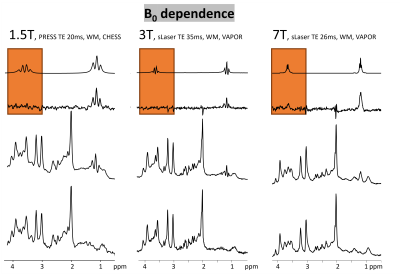 |
Screen Number: 32
0597. Clues
from 1H MR spectroscopy about the cerebral micro-environment of
ingested ethanol
R. Kreis, J. Mosso, G. Weng, K. Simsek, C. Boesch, J.
Slotboom, A. Döring
University Bern, Bern, Switzerland
Impact:
The explored partial and B0-dependent detectability of brain ethanol may give insight into its microenvironment and could scale with the extent of physiologic effects. Ethanol’s differential and field-dependent T2s may serve as prototype for studying binding properties of endogenous metabolites. |
| 13:44 |
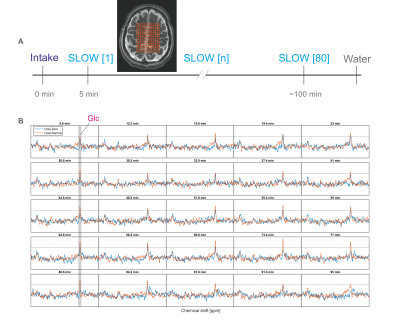 |
Screen Number: 33
0598. Have
a Coke and a Smile: Sweet Insights into Brain Glucose Dynamics
with SLOW-EPSI
G. Weng, P. Radojewski, J. Slotboom
University of Bern, Bern, Switzerland
Impact: This method offers a practical approach to
monitor brain glucose dynamics, supporting nutritional
research and enhancing understanding of how dietary intake
influences brain metabolism, with potential implications for
studies on diabetes and other metabolic disorders.
|
| 13:46 |
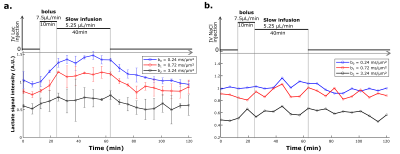 |
Screen Number: 34
0599. Probing
transient changes in intracellular-extracellular lactate
distribution in the mouse brain during i.v. lactate infusion
using dMRS
S. Malaquin, J. Valette, C. Baligand
Université Paris-Saclay, CEA, CNRS, MIRCen, Laboratoire des Maladies Neurodégénératives, Fontenay-aux-Roses, France
Impact: We were able to non-invasively capture transient
changes in intracellular-extracellular lactate distribution
using dMRS, and it would be invaluable to estimate its
vascular fraction and exchange kinetics between compartments
to better understand lactate’s role in brain function.
|
| 13:48 |
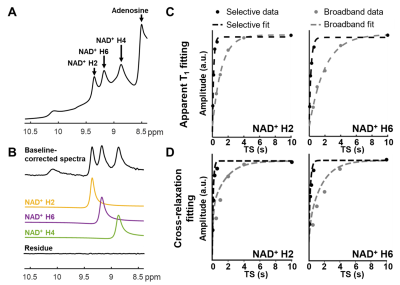 |
Screen Number: 35
0600. Quantification
of NAD+ proton cross-relaxation with water using downfield 1H
MRS in the human brain at 7 T

S. Swago, N. Wilson, M. Elliott, R. Armbruster, R. P. R.
Nanga, R. Reddy, W. Witschey
University of Pennsylvania, Philadelphia, United States
Impact: NAD+ cross-relaxation in human brain can be
exploited to increase sensitivity through T1-shortening, and
its quantification may provide insights into metabolite
binding in vivo.
|
| 13:50 |
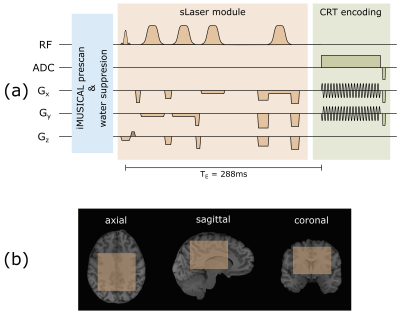 |
Screen Number: 36
0601. Measuring
Lactate Levels in Gray and White Matter of the healthy Human
Brain using semi-LASER MRSI with Concentric Ring Trajectory
Encoding at 3T

V. Bader, B. Strasser, W. Bogner, L. Hingerl, S. Frese,
A. Duguid, A. Osburg, M. Marjańska, S. Motyka, M.
Krššák, T. Scherer, R. Lanzenberger, F. Niess
Medical University of Vienna, Vienna, Austria
Impact:
Capturing time-resolved regional Lac-levels could improve understanding of various pathologies characterized by abnormal levels. The proposed versatile sLASER-CRT-MRSI-sequence allows spectral averaging over specific brain regions and could help detect metabolic changes associated with pathologies and improve diagnostic and therapeutic approaches. |
| 13:52 |
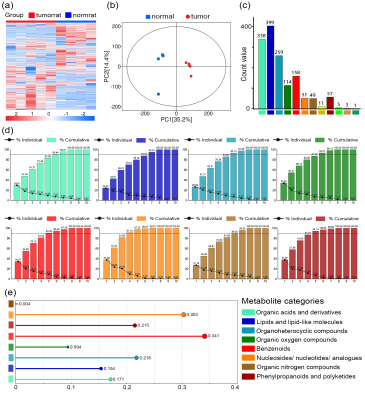 |
Screen Number: 37
0602. Insight
in metabolic changes of early and late stage glioma revealed by
both downfield MRS and Non-targeted Metabolomics
X. Zhu, Y. Cao, Y. Zhou, K. Zhou, D. Lin, S. You, Z. He, S.
Chen, C. Cai, Y-C Hsu, M. Wang
Zhejiang University, Hangzhou, China
Impact: Downfield MRS signal differences between normal
and tumor tissues at different stages enhance tumor
metabolism diagnosis. Correlations with nucleotides and
other metabolic pathways suggest these non-conventional
peaks as potential novel biomarkers for cancer metabolism.
|
| 13:54 |
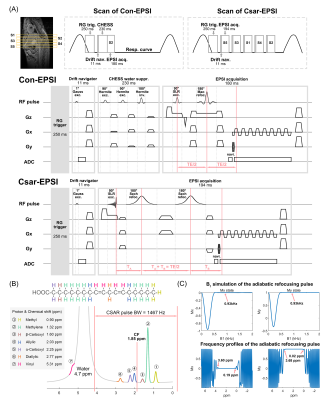 |
Screen Number: 38
0603. Novel
lipid-targeted echo-planar spectroscopic imaging technique for
in-vivo lipid composition measurement
D. Lin, K. Zhou, Y. Zhou, X. Zhu, S. You, Y. Cao, J. Zhou,
F. Chen, C. Cai, Y-C Hsu, M. Wang
Zhejiang University, Hangzhou, China
Impact: Csar-EPSI enables rapid and precise assessment
of lipid composition in vivo. Its enhanced sensitivity and
reliability provide critical insights into metabolic
disorders, paving the way for improved diagnostics and
personalized treatments in high-field human abdominal MRI
applications.
|
| 13:56 |
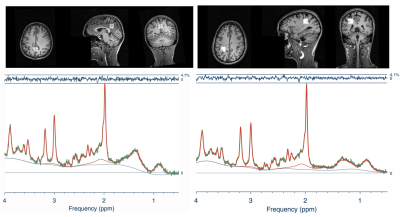 |
Screen Number: 39
0604. Sex
Differences in Brain Metabolites after mild Traumatic Brain
Injury: The Role of Hormonal Influences using 3T MRS
L. Fuchs, K. Breedlove, T. Shic, S. Rusche, N. Sollmann, J.
Strobel, A. Betz, M. Van den Nieuwenhof, S. McComas, I.
Koerte, A. Lin
Center for Clinical Spectroscopy, Brigham and Women´s Hospital, Harvard Medical School, Boston, United States
Impact: Our results reveal hormone-dependent metabolic
changes in the brain post-mTBI, emphasizing the role of
estradiol in neuroprotection and the complexity of intake of
oral contraceptives. This could inform future sex-specific
therapeutic strategies for mTBI patients.
|
| 13:58 |
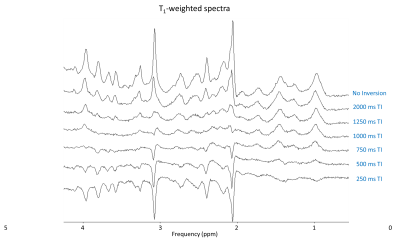 |
Screen Number: 40
0605. Metabolite
T1 and T2 relaxation times in the macaque brain at 11.7T with
local B1+ shimming
A. Lopez Kolkovsky, M. Gay, M. Roustan, T. Lilin Froment, A.
Massire, A. Amadon, F. Mauconduit, F. Boumezbeur
CEA, Gif-sur-Yvette, France
Impact: Increased accuracy for metabolite concentration
estimation and optimal acquisition parameters to maximize
temporal SNR at 11.7T. Parallel transmission elicited a
large reduction in the required RF power for a 2.25 mL
cortical voxel using a dedicated 6Tx/6Rx surface coil.
|
| 14:00 |
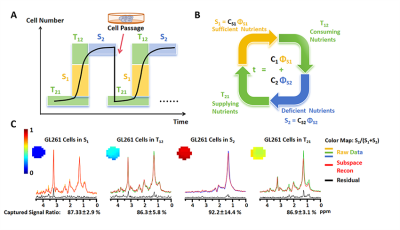 |
Screen Number: 41
0606. Cell-Resolved
MR Spectroscopic Signatures for Cancer Cells Mapping: Dual-State
Subspaces and GFP-Labeled Glioma Mouse Validation
Y. Wang, U. Saha, S. Liu, E. Roy, A. Smith, F. Lam
University of Illinois Urbana-Champaign, Urbana, United States
Impact: The proposed approach can assess cell-specific
tissue responses, with significant potentials for tumor
staging, treatment assessment, and recurrence detections.
|
| 14:02 |
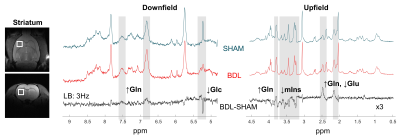 |
Screen Number: 42
0607. Insights
from the downfield proton MR spectrum: establishing peak
assignments and novel pathophysiologic findings in hepatic
encephalopathy

J. Mosso, R. Kreis, B. Lanz, C. Cudalbu
CIBM Center for Biomedical Imaging, Lausanne, Switzerland
Impact: Metabolite-cycled 1H-MRS
used here in an animal model of hepatic encephalopathy
enabled unique access to energy metabolites with downfield
resonances (glucose, ATP) and will shed new light on energy
metabolism alterations at stake in this disease.
|
| 14:04 |
Screen Number: 43
0608. WITHDRAWN |
|
| 14:06 |
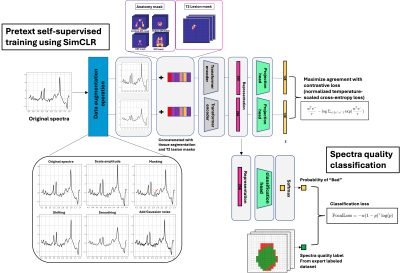 |
Screen Number: 44
0609. Automated
MRS quality control across diverse acquisitions and neurological
diseases using self-supervised transformers

J. Lee, S. Vaziri, N. Tran, D. Xu, Y. Li, J. Lupo
UCSF, San Fransisco, United States
Impact: This approach enables automated quality control
for MRS, reducing reliance on manual assessments. It
enhances diagnostic accuracy, supports broader clinical
adoption, and may reveal complex interdependencies, thus
improving our understanding of neurological disease
progression and treatment responses
|
| 14:08 |
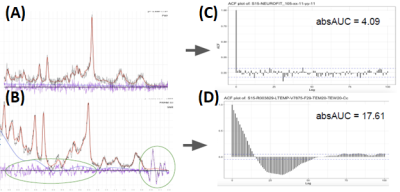 |
Screen Number: 45
0610. Visual
Evaluative Control Technology Of Resonance Spectroscopy
(VECTORS): Automated Data Quality Control Pipeline for
Spectroscopy Data

B. Beroukhim, Z. Lan, V. Halkotar, S. McComas, K.
Breedlove, A. Lin
Brigham and Women's Hospital, Boston, United States
Impact: As a comprehensive, automated, and efficient MRS
DQC process, the pipeline can help standardize DQC and
expand the field to scientists with little MRS expertise.
The pipeline should be used in addition to standard
quantitative metrics.
|
| 14:10 |
 |
Screen Number: 46
0611. A
Multi-Resolution Fitting Approach for 31P MRSI
J-P Schmitz, V. Franke, J. Platek, P. Bachert, M. Ladd, A.
Korzowski
German Cancer Research Center (DKFZ), Heidelberg, Germany
Impact:
We present a quantification approach improving the quantification robustness of low-concentrated metabolites in high-resolution 31P MRSI datasets, yielding the potential for effective measurement time reduction of 31P MRSI in vivo. |
| 14:12 |
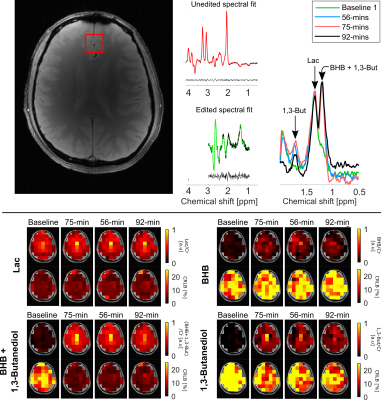 |
Screen Number: 47
0612. Metabolism
in the human brain following oral consumption of a keto-ester
for applications in alcohol use disorder (AUD) with 1H-MRSI
M. Virk, R. Kitaneh, M. Mignosa, S. McIntyre, T. Nixon, K.
DeMartini, S. O’Malley, J. Krystal, H. De Feyter, G.
Angarita, G. Mason, R. de Graaf, C. Kumaragamage
Cumming School of Medicine, University of Calgary, Calgary, Canada
Impact: Accurate BHB quantification is critical to
evaluate BHB transport into the brain post-keto-ester
consumption. A modified J-difference editing strategy is
expected to mitigate shortcomings to investigate BHB
transport to assess disease severity and gain insights
related to craving in AUD.
|
| 14:14 |
 |
Screen Number: 48
0613. Towards
31P-informed 1H MRSI: A framework for the analysis of shared
spectral features in vivo

J. Platek, F. Kroh, V. Franke, P. Bachert, M. Ladd, A.
Korzowski
German Cancer Research Center, Heidelberg, Germany
Impact: The exploitation of mutually correlated spectral
features in vivo from different molecular MR techniques,
e.g. 31P and 1H MRSI, enables the identification of
potential new surrogate markers.
|
| 14:16 |
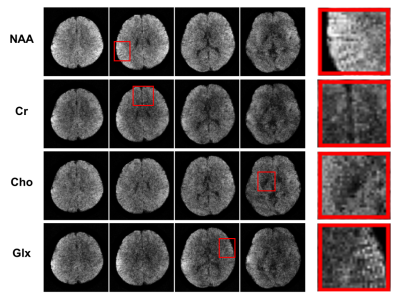 |
Screen Number: 49
0614. Ultrahigh-Resolution
Mapping of Brain Metabolic Structures at Ultrahigh Field
R. Guo, Y. Li, Y. Zhao, W. Jin, Y. Chai, Y. Li, B. Sutton,
Z-P Liang
Siemens Healthineers, St Louis, United States
Impact: This work demonstrates the feasibility of
ultrahigh-resolution mapping of brain metabolic structures
using MRSI. The proposed method offers a new potential for
exploring brain metabolism with unprecedented details.
|
| 14:18 |
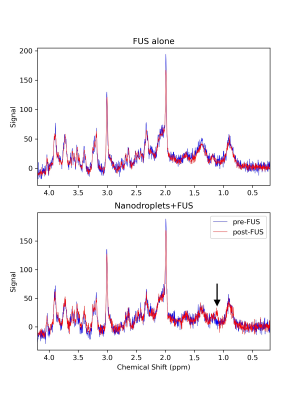 |
Screen Number: 50
0615. Detection
of ultrasound-sensitive nanodroplets with proton magnetic
resonance spectroscopy
C. Bailey, T. Rabelo, S-K Wu, C. Hamani, J. Near, H.
Lea-Banks
Sunnybrook Research Institute, Toronto, Canada
Impact: Proton MRS has potential for monitoring the
delivery of lipid nanodroplets in
vivo. Nanodroplets can incorporate drugs and be
targeted to specific brain regions using focused ultrasound.
Future MRS studies will examine effects of drug release and
dose on MRS.
|
The International Society for Magnetic Resonance in Medicine is accredited by the Accreditation Council for Continuing Medical Education to provide continuing medical education for physicians.